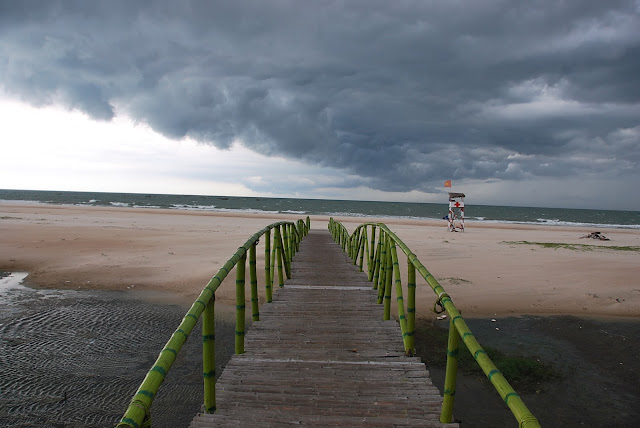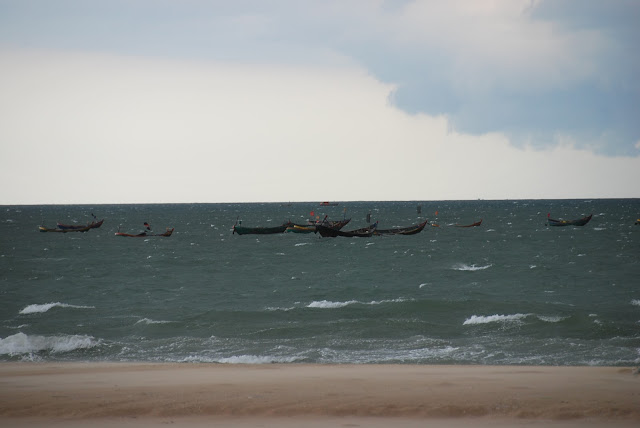Related Pots
 |
| Ho Tram Beach, Ba Ria - Vung Tau - Photo by An Bui |
 |
| Ho Tram Beach, Ba Ria - Vung Tau - Photo by An Bui |
| Ho Tram Beach, Ba Ria - Vung Tau - Photo by An Bui |
 |
| Ho Tram Beach, Ba Ria - Vung Tau - Photo by An Bui |
 |
| Ho Tram Beach, Ba Ria - Vung Tau - Photo by An Bui |
| Ho Tram Beach, Ba Ria - Vung Tau - Photo by An Bui |
 |
| Ho Tram Beach, Ba Ria - Vung Tau - Photo by An Bui |
 |
| Ho Tram Beach, Ba Ria - Vung Tau - Photo by An Bui |
Related Pots
Dai Lanh is one of the most beautiful beaches in Vietnam and its easternmost point
Although it is not known as well known as Nha Trang, Mui Ne, or Phan Thiet among foreign tourists, Dai Lanh Beach, some 80 kilometers to the north of Nha Trang, offers unique views and experiences that make it a fine destination for a day trip.
The gently curving beach, which is mostly surrounded by mountains, is four meters long and slopes gradually, allowing people to swim far out into the water. The water is calm and very clear, and the sand is white. A stream nearby offers children a good place to swim.
Tuan Le coconuts, grown by farmers in Van Ninh District, where the beach is located, is believed to be among the best in Vietnam.
Seafood lovers should take a boat trip to a nearby fishing village, where fresh fish, squid, and snails are always available. Spicy squid hot pot with a variety of squids is a highly recommended specialty there.
Dai Lanh beach became famous in 1836 when King Minh Mang, the second Nguyen Dynasty (1802-1945) ruler, ordered its picture to be carved into the nine cauldrons placed in the yard of the imperial citadel in Hue.
Later, in 1853, King Tu Duc, the dynasty’s fourth sovereign, made “Dai Lanh” nationally popular by ordering its development, allotting funds for infrastructure and other works.
It was once named one of the most beautiful beaches in Southeast Asia by the World Tourism Organization.
Not far the beach is Cape Dai Lanh in Dong Hoa District in neighboring Phu Yen.
Surrounded by mountains belonging to the transnational Truong Son Range, the country’s easternmost cape, also known as Varella Cape, is famous for a 26.5-meter high lighthouse built by the French in 1890 during their colonization.
The lighthouse, with a staircase with 108 steps to the top, offers a perfect vantage point to observe the landscape. It is recommended that tourists stay overnight at the lighthouse to observe the sun rising over Vietnam.
Cape Dai Lanh itself is a landscape worth discovering. Thanks to a stream that separates it from the mainland, the cape looks likes an island. At the foot of the mountain range is Mon beach, which is like a miniature version of Dai Lanh Beach.
One popular adventurous activity in Dai Lanh is accompanying fishermen to catch ca chinh (eels) dubbed “sea serpent” in Vietnamese folklore due to its fierce nature.
An eel could weigh just five to seven kilograms but defeat the efforts of a man weighing 10 times that to subdue it. Some can weigh dozens of kilograms and measure nearly 1.5 meters long, so it is advisable to go fishing in groups of three.
Since the eel usually lives in deep caves, fishermen have to wait for the tide to rise gradually before using chum, or ground fish, as bait to lure it out.
Though eels fetch millions of dong, not many fishermen try to catch them because the process is difficult and time-consuming and depends much on luck. Moreover, its bite has anticoagulants.
Nevertheless, adventure lovers should not miss the experience when they are in Dai Lanh.
HOW TO GET THERE?
Nha Trang – Dai Lanh Beach:
By train: Take N12 that plies the Nha Trang – Tuy Hoa route, and get off at Dai Lanh Gas Station, Van Ninh District. It leaves Nha Trang at 6.30 a.m. every day. On the return trip it arrives at Dai Lanh at 3.44 p.m.
From there, take a motorbike or car to the Ca mountain pass. The beach is located at the end of the pass.
By car: Book tickets at the Nha Trang branches of Mai Linh Company (phone: 058. 359 0606) or Thuan Thao Company (Phone: 058. 3 560 818 - 3 560 828).
To Cape Dai Lanh:
From Tuy Hoa, Phu Yen: Go by car or motorbike along the Phuoc Tan – Bai Nga Street for around 30 kilometers.
From Nha Trang: By car, go along the Ca mountain pass for 100 kilometers to reach the Khanh Hoa – Phu Yen border. From there go along the Phuoc Tan – Bai Nga Street for another 12 kilometers.
Source Thanh Nien News
Although it is not known as well known as Nha Trang, Mui Ne, or Phan Thiet among foreign tourists, Dai Lanh Beach, some 80 kilometers to the north of Nha Trang, offers unique views and experiences that make it a fine destination for a day trip.
The gently curving beach, which is mostly surrounded by mountains, is four meters long and slopes gradually, allowing people to swim far out into the water. The water is calm and very clear, and the sand is white. A stream nearby offers children a good place to swim.
Tuan Le coconuts, grown by farmers in Van Ninh District, where the beach is located, is believed to be among the best in Vietnam.
Seafood lovers should take a boat trip to a nearby fishing village, where fresh fish, squid, and snails are always available. Spicy squid hot pot with a variety of squids is a highly recommended specialty there.
Dai Lanh beach became famous in 1836 when King Minh Mang, the second Nguyen Dynasty (1802-1945) ruler, ordered its picture to be carved into the nine cauldrons placed in the yard of the imperial citadel in Hue.
Later, in 1853, King Tu Duc, the dynasty’s fourth sovereign, made “Dai Lanh” nationally popular by ordering its development, allotting funds for infrastructure and other works.
It was once named one of the most beautiful beaches in Southeast Asia by the World Tourism Organization.
Not far the beach is Cape Dai Lanh in Dong Hoa District in neighboring Phu Yen.
Surrounded by mountains belonging to the transnational Truong Son Range, the country’s easternmost cape, also known as Varella Cape, is famous for a 26.5-meter high lighthouse built by the French in 1890 during their colonization.
The lighthouse, with a staircase with 108 steps to the top, offers a perfect vantage point to observe the landscape. It is recommended that tourists stay overnight at the lighthouse to observe the sun rising over Vietnam.
Cape Dai Lanh itself is a landscape worth discovering. Thanks to a stream that separates it from the mainland, the cape looks likes an island. At the foot of the mountain range is Mon beach, which is like a miniature version of Dai Lanh Beach.
One popular adventurous activity in Dai Lanh is accompanying fishermen to catch ca chinh (eels) dubbed “sea serpent” in Vietnamese folklore due to its fierce nature.
An eel could weigh just five to seven kilograms but defeat the efforts of a man weighing 10 times that to subdue it. Some can weigh dozens of kilograms and measure nearly 1.5 meters long, so it is advisable to go fishing in groups of three.
Since the eel usually lives in deep caves, fishermen have to wait for the tide to rise gradually before using chum, or ground fish, as bait to lure it out.
Though eels fetch millions of dong, not many fishermen try to catch them because the process is difficult and time-consuming and depends much on luck. Moreover, its bite has anticoagulants.
Nevertheless, adventure lovers should not miss the experience when they are in Dai Lanh.
HOW TO GET THERE?
Nha Trang – Dai Lanh Beach:
By train: Take N12 that plies the Nha Trang – Tuy Hoa route, and get off at Dai Lanh Gas Station, Van Ninh District. It leaves Nha Trang at 6.30 a.m. every day. On the return trip it arrives at Dai Lanh at 3.44 p.m.
From there, take a motorbike or car to the Ca mountain pass. The beach is located at the end of the pass.
By car: Book tickets at the Nha Trang branches of Mai Linh Company (phone: 058. 359 0606) or Thuan Thao Company (Phone: 058. 3 560 818 - 3 560 828).
To Cape Dai Lanh:
From Tuy Hoa, Phu Yen: Go by car or motorbike along the Phuoc Tan – Bai Nga Street for around 30 kilometers.
From Nha Trang: By car, go along the Ca mountain pass for 100 kilometers to reach the Khanh Hoa – Phu Yen border. From there go along the Phuoc Tan – Bai Nga Street for another 12 kilometers.
Source Thanh Nien News
Related Pots
The 16th Southern Fruit Festival opened June 1 at the Suoi Tien Theme Park in Ho Chi Minh City’s District 9.
The festival, which will remain open throughout the three months of summer, is held by the city’s Department of Culture, Sports and Tourism and the HCMC Tourism Association.
Over 1000 tons of fruit of all kinds are expected to be consumed by millions of tourists during the annual festival.
As in previous years, this year’s festival includes a floating fruit market, fruit competition and exhibition, fashion show, food booths and a fruit parade that was held during the opening ceremony.
Around 65 kinds of fruits displayed at the festival will be sold at between VND3,000-10,000 per kilogram lower than market prices, organizers said.

By Phuong Anh, Thanh Nien News
The festival, which will remain open throughout the three months of summer, is held by the city’s Department of Culture, Sports and Tourism and the HCMC Tourism Association.
Over 1000 tons of fruit of all kinds are expected to be consumed by millions of tourists during the annual festival.
As in previous years, this year’s festival includes a floating fruit market, fruit competition and exhibition, fashion show, food booths and a fruit parade that was held during the opening ceremony.
Around 65 kinds of fruits displayed at the festival will be sold at between VND3,000-10,000 per kilogram lower than market prices, organizers said.

By Phuong Anh, Thanh Nien News











